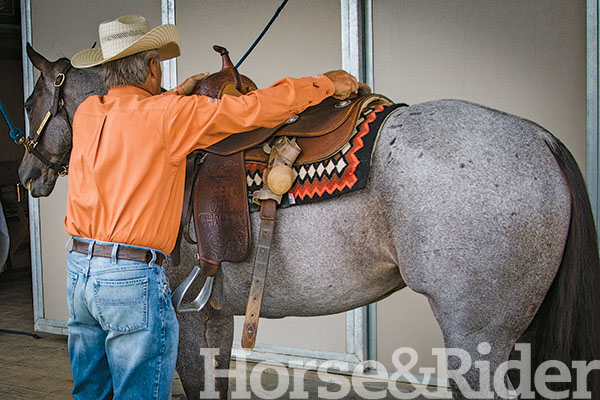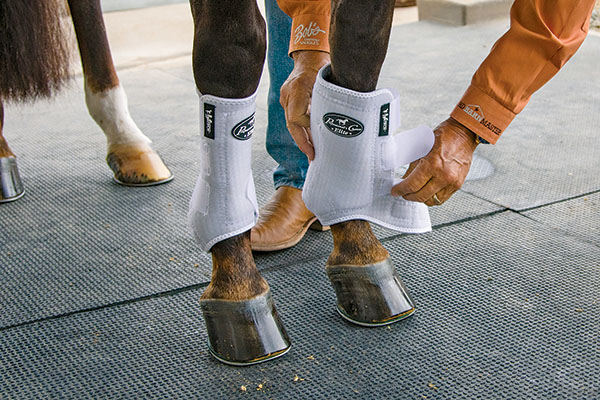The tack I use for everyday riding gets used. It sees many horses on a daily basis, so it has to last. A horseman is like a mechanic in terms of our tools of our trades—we want the best we can get, we use them hard, and we take pride in what we have and take care of our gear so it’ll last.

You might not ride more than one horse a day, but that doesn’t mean you should skimp on your working gear. High-quality tack keeps your horse comfortable, which is worth the investment on its own. Here, I’ll go over the qualities I look for in my daily riding gear, as well as offer tips for caring for each piece.
Saddle pads
What I look for: I use the same kind of pad on every horse I ride. Breathability is key. It helps keep the horse cool under saddle, which slows the rate of fatigue. The pad’s core absorbs shock for the horse’s comfort, and the Navajo top means I can use the same pad in the show pen as I do at home.
Care tip: Allow your pad to dry between uses. This prevents mold and mildew. Your climate will dictate how long it takes for a pad to dry. Here in Temecula, California, my pads dry quickly. But when I was in Oregon, the humidity required longer drying time.
Purchase a new Western saddle pad on Amazon!
Products we feature have been selected by our editorial staff. If you make a purchase using the links included, we may earn a commission. For more information click here.
Cinches
What I look for: I prefer neoprene cinches for their ease of care, but I sometimes use fleece-lined cinches on horses that work better in them. I most often use a roper cinch, because I prefer the wider design. Some narrow cinches seem to “cut a horse in half.” When I have a horse saddled for a while, I want him to be comfortable. The wide roper cinch offers more support when my horse is standing tied and when he’s working.
Care tip: Keep your cinch clean. Proper care will prevent galls and sores, as well as make the cinch last longer. Replace it at the first sign of cracking if it’s neoprene.
Browse new Western cinches!
Protective legwear
What I look for: Protective legwear has come a long way. I look for boots that fit the shape of the horse’s legs that have a suspensory strap for support. I use them on front and hind legs on all of my horses—ropers, reiners, cow horses, cutters, and colts. Ventilation is key to keep my horse’s soft tissues from overheating, which can lead to injury. Most of my horses wear white boots, so I keep clean sets for the show pen, washing them regularly. Once they get too dirty for competition, they move to everyday work boots. I replace them when the hook-and-loop closures wear out. Boots can’t do their job if the closures are loose.

Care tip: Clean all dirt and hair from boots after each use. For a deeper clean, wash them in a bucket with a mild detergent or horse shampoo, rinse well (important to prevent skin irritation), and let them dry completely before using. Machine-washing can negate a product’s warranty, so stick to the bucket.
Check out protective legwear on Amazon!
Working headstalls
What I look for: Good-quality leather lasts and does the job. I have working headstalls that I bought 30 years ago that are still in good shape because they’re made of high-quality leather and I take good care of them. I have browband headstalls for my snaffles and otherwise use floating-ear headstalls.
Care tip: Go through all of your leather tack three or four times a year, and give it a good cleaning and conditioning. If you notice that your leather is dry, condition it immediately. Just like with your saddle pads, keep your climate in mind. When I was in Oregon, I had a dehumidifier in my tack room to prevent mold. Now, in California, I have to condition my leather more often to keep it soft and in good shape.
Correction bit
What I look for: This is the first bit I grab when I start a young horse in the bridle. I also use it on a 14-year-old gelding in my barn, so it’s not just for youngsters. It does it all, from reining to cutting to starting colts.

Care tip: Keep an eye on all the bit’s moving parts. The joints should move easily, but not be too sloppy nor too tight. Watch for sharp edges, pinching joints, and other aspects that could irritate or injure your horse’s mouth. If you buy from a reputable bit maker, you shouldn’t have to worry too much.
Half-and-half twist snaffle
What I look for: I reach for this bit after I’ve started my horse in a smooth snaffle and he’s going well in it. The twist gives it a touch more feel than a regular snaffle, but not so much that you’ll scare the horse. Just about anyone can use this bit, from a pro to an amateur rider.
Care tip: For a quick, everyday cleaning, swish your bits around in a bucket of water with a few drops of vinegar. For a deeper clean, soak the bit in hot water, and then use a toothbrush and toddler toothpaste.






